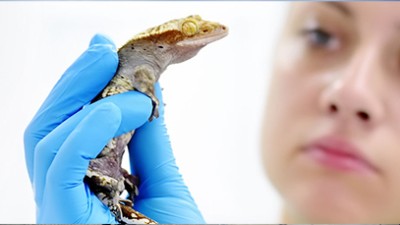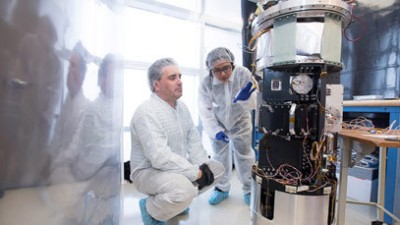News
-
March 8, 2020
![man holding microphone giving presentation on a stage.]()
Datto founder reflects on company's growth
WHEC-TV talks to RIT trustee and 2009 alumnus Austin McChord, founder and CEO of Datto.
-
March 4, 2020
![rendering of planet in space in foreground and sun in the background.]()
Weekly Space Hangout: Did RIT Scientists Find A Baby Giant Planet?
Universe Today features Joel Kastner, professor in the Chester F. Carlson Center for Imaging Science, and astrophysical sciences and technology Ph.D. students Annie Dickson-Vandervelde and Emily Wilson.
-
March 4, 2020
![professor talking in front of cabinet full of various sized bottles.]()
Measuring greenhouse gases in your backyard could soon be a reality
WROC-TV talks to Kalathur Santhanam, professor in the School of Chemistry and Materials Science, and Reeba Thomas, a materials science graduate student, about a device that measures greenhouse gases in real time.
-
February 25, 2020
![photo of graduate student Alexandria Shumway]()
Student to Student: Brittle stars
While interested in science, Alexandria Shumway had never heard of bioinformatics before attending RIT. But after branching out and trying a new major, she discovered it was the perfect fit.
-
February 18, 2020
![female student working in biotechnology lab]()
Student to Student: Antibiotic resistance
At the end of her first year at RIT, Nicole Cavanaugh began working for the Hudson Lab. Today, she works as a research apprentice at the Roswell Park Cancer Institute where she is preparing for her Ph.D.
-
February 17, 2020
![professor presenting at a conference]()
Strong presence by RIT faculty and alumni at Imaging Science symposium
Chester F. Carlson Center for Imaging Science at RIT had a strong presence during a recent symposium including a newly established conference organized by former Ph.D. students.
-
February 10, 2020
![Artist's conception of a massive planet orbiting a cool, young star.]()
RIT scientists discover the nearest-known ‘baby giant planet’
Scientists from RIT have discovered a newborn massive planet closer to Earth than any other of similarly young age found to date. The baby giant planet lies only about 330 light years from our solar system. The discovery, published in the Research Notes of the American Astronomical Society, provides researchers an exciting new way to study how gas giants form.
-
February 4, 2020
![photo of Reid Kamhi]()
Student to Student: Internship experience
Getting internships wasn't always easy, but Reid Kamhi never gave up. He knew the importance of adding project experience to his resume. In this spotlight, he shares his story and offers tips to other RIT students looking for internship opportunities.
-
January 14, 2020
![male student working on equipment in chemistry lab]()
Student to Student: Sustainable systems
By researching sustainable systems today, RIT student Ibrahim Cisse hopes to make an impact in the world tomorrow.
-
December 17, 2019
![female student working in biotechnology lab]()
Student to Student: Antibiotic resistant bacteria
After attending the College and Careers program at RIT, Kaylee Steiner discovered the Biotechnology program and realized it was more closely aligned with her interests.
-
December 13, 2019
![]()
New applied cognitive neuroscience course offered at RIT
Designed for students who want to learn how animals transform light and other radiation into information, the Animal Vision course explores the varied approaches to visually acquiring information employed by animals.
-
December 12, 2019
![large and small satellite dishes.]()
RIT and IAR observe pulsars for the first time from South America
A team from RIT and the Instituto Argentino de Radioastronomía (IAR) upgraded two radio telescopes in Argentina that lay dormant for 15 years in order to study pulsars, rapidly rotating neutron stars with intense magnetic fields that emit notably in radio wavelengths. The project is outlined in a new paper published in Astronomy and Astrophysics.
















